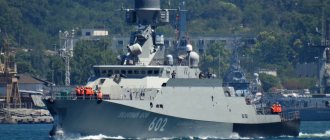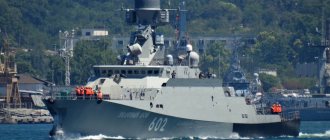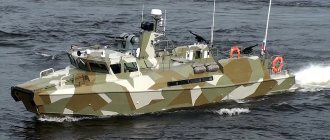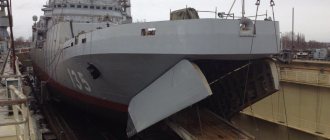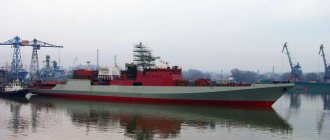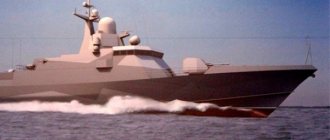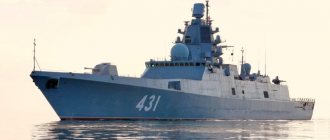How will the icebreaker be tested?
Mooring tests of the patrol icebreaker will begin at the end of 2022. This is the first stage of testing that any ship goes through before being put into operation. Even partially completed ships can participate in them. During mooring tests, engineers carry out basic checks of all units and systems installed on the ship. This is done in order to confirm the basic characteristics of combat and technical equipment and the entire ship as a whole and their compliance with the ship’s specifications, technical conditions, drawings, diagrams, descriptions and operating instructions.
Next, Ivan Papanin will undergo factory sea trials in the third quarter of 2023. They are produced for the purpose of checking, under sea conditions, the main characteristics of combat and technical equipment and the entire ship as a whole for compliance with the approved parameters. “Ivan Papanin” will go to sea, and its onboard equipment will be tested in real conditions. This will be the final process of construction of Ivan Papanin.
Article on the topic
Sailor, security officer, polar explorer. Why is Ivan Papanin respected and hated?
Borderline option
“Blizzard” and its brother, capable of overcoming almost two-meter ice, were ordered from the Vyborg Shipyard by the Border Service of the FSB of Russia. The patrol ships (total displacement according to the project is 8,500 tons) are identical in appearance, parameters and technical characteristics to the ships that were built under the code “Arctic” for the Russian Navy. The only difference is in the set of weapons. The contract for two patrol icebreakers for maritime border guards worth 18 billion rubles (deadline: end of 2024 and end of 2025) marks a new milestone in the history of the Border Service - “Purga” will become the first large-capacity ice-class vessel as part of the coast guard.
As is known, the construction of the lead ship of the same class in the interests of the Russian Navy was carried out by Admiralty Shipyards JSC. The patrol icebreaker "Ivan Papanin", equipped with tactical strike weapons - the "Caliber" missile system and the "Uran" complex, was launched on October 25, 2022. Now it is being completed afloat and preparing for mooring and factory sea trials. State tests and transfer to the fleet are planned for the end of 2023.
© mil.ru The patrol icebreaker “Ivan Papanin” was launched on October 25, 2019.
What are the characteristics of the vessel?
The icebreaker “Ivan Papanin” was launched in 2022. With a length of 114 meters and a width of 20 meters, its displacement is 8.5 thousand tons. Outside the ship's hull, two all-wheel drive rudder columns of the Azipod Vi1600L type are mounted on hinge mechanisms, so the propellers can rotate around a vertical axis by 360 degrees. This provides the icebreaker with high maneuverability.
“Ivan Papanin” reaches speeds of up to 18 knots and can overcome ice fields up to 1.7 meters thick. The ship's autonomy is 70 days, and its range is ten thousand nautical miles. The icebreaker's weapons include an AK-176MA artillery mount, a Kalibr cruise missile launcher, and a multi-purpose helicopter.
Project 23550 combat icebreaker Ivan Papanin, Wikipedia, photo
The icebreaker was launched on October 25 in the waters of St. Petersburg. The vessel can be operated in Arctic ice up to 1.5 meters thick and in tropical waters.
According to the publication, the operation of the Ivan Papanin began against the backdrop of Russia’s rapid military and economic development in its strategic Arctic region.
Foreign media also note the uniqueness of the project, which lies in its weapons. Previously, no icebreaker had the Club-K missile systems and the 100-mm A190-01 launcher. Thanks to them, the Russian ship is capable of attacking almost any target, from aviation and coastal targets to large aircraft carriers.
What kind of project does “Ivan Papanin” include?
Ice-class patrol ships of Project 23550 (also called “Arktika” or “Ermak”) have been developed since 2016 after the closure of the military icebreaker project 21180, for which only one ship was built: “Ilya Muromets”. The military decided that they needed more multi-functional vessels.
Protection from fools. Why is the US Navy alarmed by the icebreaker Ivan Papanin? More details
Therefore, Project 23550 ships are designed for different tasks: escorting other ships, towing, monitoring Arctic waters, escorting support vessels and escorting detained ships. They are designed for use in the north, have guided missile weapons for the near and far sea zones, and have the capabilities of an icebreaker, tugboat and patrol ship. Ships of this project can operate in any navigation zones - from tropical to arctic - overcoming ice of the greatest thickness up to 1.7 m.
So far, the Ministry of Defense has plans for only two patrol icebreakers under Project 23550: Nikolai Zubov and Ivan Papanin. “Nikolai Zubov” is planned to be launched in 2024.
"Ivan Papanin" and project 23550. Warship for peaceful work
On October 25, at the shipbuilding plant in St. Petersburg, a solemn ceremony of launching the lead patrol ship “Ivan Papanin”, built according to the new project 23550 “Arktika”, took place. Construction of a second ship of the same type is expected to begin soon. Two new pennants will ensure more effective development and protection of the Arctic in the foreseeable future.
Image of the ship pr. 23550 from promotional materials
Construction progress
All work on project 23550 is carried out by enterprises from the United Shipbuilding Corporation.
The project of a multi-purpose patrol ship was developed at the Almaz Central Marine Design Bureau, and construction was entrusted to the Admiralty Shipyards. A number of other enterprises are participating in the construction program as equipment suppliers. The contract for the construction of two Arctic ships for the Ministry of Defense was signed in April 2016. In accordance with the document, the lead ship Ivan Papanin was to be delivered to the customer by the end of 2022. The next Nikolay Zubov was planned to be laid down in 2018 and delivered in 2020 However, already during construction the financing plan was changed, as a result of which the deadlines for completing the work shifted to the right.
Work on the design of “Ivan Papanin” began in the fall of 2016, and on April 19, 2017, the official laying took place. On October 25, 2019, the ship was launched for subsequent completion at the wall. In the early twenties, the lead ship will be tested. Its delivery is scheduled for 2023.
Plans for Nikolai Zubov have also been adjusted. It was not laid down in 2022 - this will happen only in 2020. The delivery deadlines have been shifted accordingly. The ship will begin service in 2024.
At the moment, only two ships of Project 23550 have been contracted for the navy. In the recent past, it was reported that such ships could also be purchased by the FSB border service, but it has not yet placed an order. Moreover, information about interest on the part of border guards has not received official confirmation.
Purpose of ships
“Ivan Papanin” and “Nikolai Zubov” belong to a unique class of universal patrol ships in the Arctic zone for our fleet.
They are designed to work in the harsh conditions of the northern seas and therefore have a special design and special tasks. Etc. 23550 provides for the construction of a patrol ship with the functions of an icebreaker and tugboat. From icebreakers, new patrol ships receive a reinforced hull and other design features that ensure operation in the Arctic. Ice class of the ship is Arc7. “Ivan Papanin” is capable of overcoming ice up to 1.7 m thick. Ice 1 m thick is broken through continuously. The design of the ship as a whole and its individual systems is adapted to the harsh northern conditions.
From the point of view of equipment and weapons, Project 23550 combines a warship and a support vessel. There are quite developed detection and destruction systems. There is also special equipment typical of rescue ships and tugs.
"Ivan Papanin" at the descent ceremony
A universal patrol ship must operate in northern latitudes and solve a number of tasks. First of all, it is a patrol aircraft, which is why it must search for and hit surface or air targets. Icebreaking capabilities can be used for one’s own benefit or to guide other vessels. For this, the ship project 23550 needs towing equipment.
Design Features
The ship, project 23550, has a total displacement of approx.
9 thousand tons with a length of 114 m and a width of 20 m. Characteristic rounded contours of the bow are provided. The multi-tiered superstructure is moved back. At its stern there is a hangar for a helicopter. To use the last food of the ship, it forms a take-off platform. The main power plant of the ship is built on the basis of four 28-9DG diesel generators produced in Kolomna with a capacity of 3.5 MW each. The Ruselprom concern supplies rowing electric motors with a capacity of 6.3 MW. The movement of the ship is provided by two such motors turning two propellers. There is also a bow thruster. The power plant provides a speed of up to 18 knots and a maximum cruising range of approx. 10 thousand miles.
The ship's crew is 60 people. It is possible to take on board 50 more people. Inventory autonomy – 70 days.
The Arctic project proposes the use of a set of various radio-electronic systems to monitor the situation, search for targets and target weapons. The use of the Positive detection and guidance radar, navigation locator, shipborne electronic warfare system, etc. is reported.
The main weapon of the patrol aircraft of Project 23550 is the bow 76-mm artillery mount AK-176MA. It is also envisaged to use smaller caliber barrel systems for protection against light watercraft. If necessary, the ship will be able to carry strike missile weapons. To do this, it is proposed to place a container version of the Caliber complex on it.
The aft hangar and platform provide a base for a Ka-27 helicopter or various types of UAVs. The ship's hull has space for transporting two high-speed boats, project 03160 "Raptor" and one hovercraft, project 23321 "Manul".
The ship, project 23550, has stern towing equipment. With its help, it is proposed to provide assistance to those in distress or tow detained ships. It is planned to install two electro-hydraulic cranes with a lifting capacity of 28 tons each to work with various loads.
Universal combat unit
Thus, in a few years, the Russian Navy, represented by the Northern Fleet, will receive the first of the promising universal ships capable of solving a wide range of combat and auxiliary missions.
Soon after this, a second ship of the same type will enter service. The implementation of the contract for two universal patrol ships, Project 23550, will have obvious positive consequences. First of all, it should be noted that the surface forces of the Navy in the Arctic will include specialized ships adapted to work in this region. At the same time, they will be able to solve their own combat missions or perform the functions of icebreakers, supporting the work of other ships.
Available data on the project indicate the possibility of installing various additional equipment, such as containers of the Kalibr complex or other equipment. Due to this, watchdogs will be able to perform various tasks, incl. transport and humanitarian nature. As noted at the ceremony of launching the Ivan Papanin, this is a warship created for peaceful work.
However, there are also reasons for criticism. Thus, the presented ship, for all its advantages, has a limited set of weapons. In the event of a collision with a serious opponent, it may not be sufficient. The patrol boat can carry Caliber missiles, but they are not part of the standard weapon system.
To protect the Arctic part of the state border and the northern seas, only two ships of Project 23550 have been ordered. The Northern Fleet has powerful surface forces, but it will only have a couple of universal patrol ships at its disposal. Perhaps in the future there will be a new order for a new type of patrol aircraft, which will strengthen the naval group.
The pace of construction is alarming. According to the 2016 agreement, the lead ship Ivan Papanin was supposed to begin service this year, but it has only just been launched. Construction of the second patrol boat was planned to begin a year ago, but has now been postponed to 2020. The reasons for such shifts are known and understandable, but the situation as a whole is cause for concern.
Nevertheless, the launch of the lead ship - even if it is behind the original schedule - is in itself a reason for optimism. This event marks the start of a new stage of work, and in a few years a fundamentally new multi-purpose ship will appear in our Navy, and not the last of its kind. Having entered service, “Ivan Papanin” and “Nikolai Zubov” will be able to demonstrate the full potential of the original concept, which may be developed in new projects.
Ships[edit]
| Name | Russian | Namesake | Builder | IMO number | Put it down | Launched | Commissioned | Status |
| Russian Navy | ||||||||
| Ivan Papanin | Ivan Papanin | Ivan Dmitrievich Papanin | Admiralty Shipyards, St. Petersburg | 9898151 | April 19, 2022 | October 25, 2022 [11] | 2023 (plan) [12] | Launched |
| Nikolay Zubov | Nikolay Zubov | Nikolai Nikolaevich Zubov | Admiralty Shipyards, St. Petersburg | 9898163 | November 27, 2022 [9] [13] | 2024 (planned) [12] | Under construction [12] | |
| Russian Border Service | ||||||||
| Blizzard | Blizzard [14] | Russian for blizzard | Vyborg Shipyard, Vyborg | 9916599 | July 25, 2022 [14] | 2024 (planned) [14] | Under construction [14] | |
| Vyborg Shipyard, Vyborg | Planned [2] | |||||||
Project representatives
Ships built by JSC "Admiralty Shipyards" (code "Arctic")
| № | Name | Airborne number | Serial number | Bookmark | Launching | Transfer to the customer | Place of duty | Notes |
| 1 | "Ivan Papanin" | 02460 | 19.04.2017 | 25.10.2019 | 12.2024[17] | It is being completed afloat, preparing for mooring trials[17] | ||
| 2 | "Nikolai Zubov" | 02461 | 27.11.2019[18] | 2024 | 12.2025[7] | SF | Under construction |
Ships built by Vyborg Shipbuilding PJSC
| № | Name | Airborne number | Serial number | Bookmark | Launching | Transfer to the customer | Place of duty | Notes |
| 3 | "Blizzard" | 235 | 25.07.2020[19] | 2023 | 12.2025[4] | BCHR FSB of Russia | Under construction | |
| 4 | 236 | 2022 | BCHR FSB of Russia | Contract signed[4] |
Table colors:
White -
not completed or disposed of without being launched
;
Green - active in the Navy
;
Yellow - operating as part of a foreign navy or as a civilian ship
;
Blue - is under repair or modernization
;
Gray - in storage
;
Red - written off, scrapped or lost
.
Design[edit]
The Project 23550 patrol ships have a planned displacement of 6,800 tons, a length of 114 meters (374 ft 0 in) and a draft of 6 meters (19 ft 8 in). [8] They are designed to break through ice up to 1.5 meters (4 ft 11 in) thick. The ships will be equipped with two Project 03160 Raptor military boats, a Ka-32 helicopter and a small hovercraft. It is planned that the main crew will be 60 people with accommodation for another 50 specialists. Armament will include a 100 mm (3.9 inch) gun (according to some sources - 76 mm, 3 inch) and 3M-54 "Caliber" anti-ship missiles.
Project 23550 will have a diesel-electric propulsion system with four 3,500-kW (4,700 hp) Kolomna 28-9DG generator sets consisting of 16-cylinder 10D49 diesel engines driving alternators manufactured by Ruselprom. In addition, the ships will have two auxiliary diesel generator sets with Kolomna diesel engines and Ruselprom generators. While the early concept used ABB Azipod azimuth thrusters, the final version used conventional shafts, propellers and rudders. Engines with a capacity of 6.3 megawatts will be produced by Ruselprom. [1] [6]The ships will have a cruising range of 60 days and a range of 6,000 nautical miles (11,000 km; 6,900 mi).
The vessels are reinforced for navigation in ice-covered Arctic seas according to the Arc7 ice class of the Russian Maritime Register of Shipping. [4] [8]
The Global Security think tank has pointed out some similarities between the 23550 design and the Norwegian Svalbard class and the Canadian Harry DeWolf class. [8] All three classes have approximately the same displacement, are capable of negotiating similar ice depths, and have similarly sized crews, with room for a mission specialist. However, the 23550 class is much better armed.
In 2022, it was announced that the Russian Navy will begin sea trials of installing modular containers on patrol ships, which will allow such ships to carry significantly upgraded weapons adapted for different missions. It was assumed that the containers would house various weapons, including sonars and torpedoes, anti-ship and cruise missiles. [10]
Analogs
The idea of a ship with an icebreaker hull and weapons is not new. During the Great Patriotic War, artillery was installed on Project 51 icebreakers. However, these were basically civilian ships. Also in Soviet times, the Project 52 ice-class border patrol ship “Purga” served in the North. However, these vessels and ships have already become history. In addition, in the 1960s and 70s, patrol icebreakers and patrol ships were built based on Project 97. Some of them still serve in the navy and coast guard.
If you look abroad, several Arctic countries have projects similar in functionality and appearance.
In 2002, the Norwegian Navy adopted the ice-class patrol ship Svalbard. Its total displacement is 6300 tons, length 103.7 m, width 19.1 m, draft - 6.5 m. The ship is equipped with radar, artillery weapons and a helicopter. According to these parameters, the Russian project 23550 is very similar to it.
Based on the Norwegian project, the ice-class ship HMCS Harry DeWolf was launched in Canada in the fall of 2022. This is the lead in a series of five coastal patrol ships in the Arctic zone. So, probably, the boom of armed icebreakers is yet to come.
Specifications
Project 23550 is a promising development; there is not much open data about it yet. It is known that with a length of about 110 m, a width of 20 m and a draft of 6 m, the ship has a displacement of about 8,500 tons. The crew consists of 60 people, additional crew - 50 people. The navigation autonomy is about 60 days, the navigation area is unlimited. Like many icebreakers, the ship uses an electric propulsion system.
During the creation process, the project evolved. The model of the Krylov Center, created at the concept stage, contains two rudder propellers (RPC). Later, their place was taken by two shaft lines with propellers and two rudders. According to some reports, it was supposed to use a VRK from ABB, however, apparently due to sanctions, it was necessary to return to the classic scheme. The wings of the pitching stabilizers, which the Krylovites love so much, have also disappeared. The result was an almost classic icebreaker with two bow thrusters.
The ice class of project 23550 is not specified. It is only reported that the ship is capable of overcoming ice up to 1.5 m thick. Taking into account the fact that, according to the customer, the ship will be able to sail in both the tropics and Arctic waters, the designers clearly had to solve a difficult problem - to combine seaworthiness and icebreakability. It seems that the icebreaker component has prevailed.
Design
Project 23550 layout.
- The total displacement of the ship according to the project is 8500 tons.
- The greatest length is 114.5 meters.
- The greatest width is 19.5 meters.
- The greatest draft is 6.5 meters.
The crew consists of 60 people, and the ships can also accommodate an additional crew of 50 people.
The ship's ice class is Arc7. The design of the hull makes it possible to overcome ice with a maximum thickness of up to 1.7 meters [7], and with continuous movement up to 1.0 meters.
On board the vessel will be based two high-speed patrol boats of Project 03160 "Raptor", which are designed to pursue and detain violators of the state border and boarding operations, a helicopter of the Ka-27 or Ka-226 type and a UAV in the deck hangar. This ship will also include one Project 23321 Manul hovercraft landing craft[8].
GEM and propulsion
This project implements the concept of a unified electric power system (UEPS) with an electric propulsion system (EDS). An electrically driven rowing unit with fixed-pitch propellers ensures the vessel's own propulsion in all operating modes.
For these ships, specialists of the Ruselprom concern have developed, manufactured and supplied ship sets of main and auxiliary diesel generators, excitation control systems, propeller electric motors and converters, as an electric propeller drive and for speed control[9]. The main power plant (GPU) of the ship is built on the basis of 4 diesel generators 28-9DG (based on 10D49 Kolomensky Zavod) with a capacity of 3.5 MW each. Ruselprom supplies 2 propulsion electric motors with a capacity of 6.3 MW each. There is also a bow thruster.
Armament
"Arctic":
- 1 × 1 - 76.2 mm AK-176MA artillery mount;
- MANPADS "Igla", "Verba".
Optional:
- 2 × 1 - 12.7 mm 6P59 Kord machine gun mounts;
- 2 container launchers of the Kalibr-K missile system: 1 × 4 types 3M-54, 3M-14 “Caliber” (40-foot ISO containers) or
- 1 × 4 anti-ship missiles of the X-35U “Uran” type (20-foot ISO containers).
"Ermak":
- 1 × 1 - 76.2 mm AK-176MA artillery mount;
- 2 × 6 - 30-mm AK-306 artillery mounts;
- 4 × 1 - 12.7 mm 6P59 Kord machine gun mounts;
- 8 × 1 MANPADS "Igla", "Verba".
Special equipment
Special equipment is represented by a towing winch with a thrust of about 80 tons and two electro-hydraulic cargo crane units with a lifting capacity of 28 tons each.


